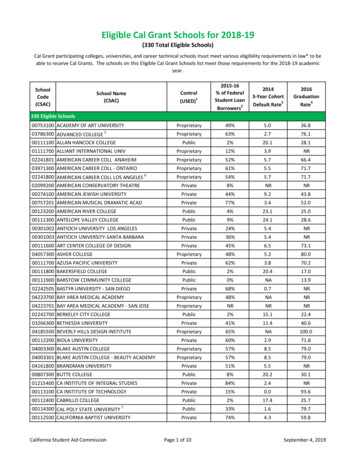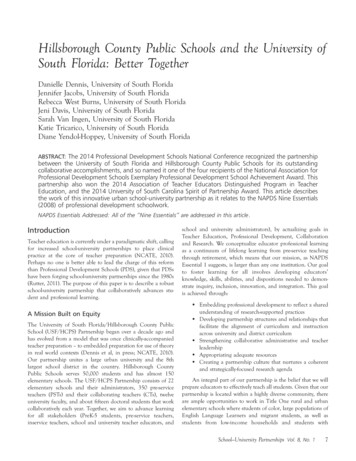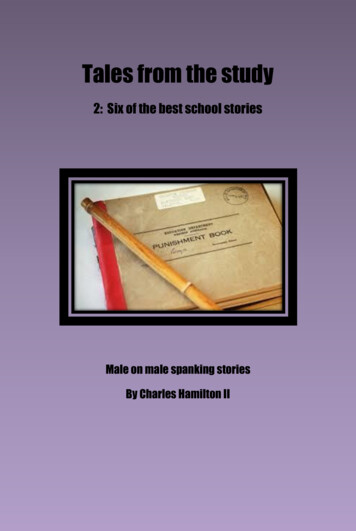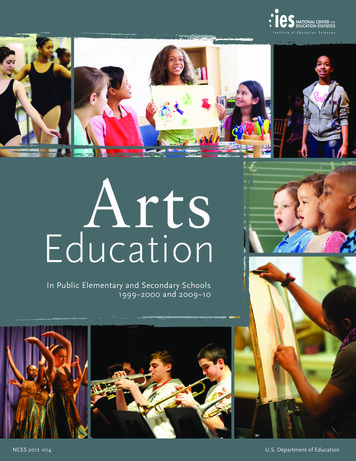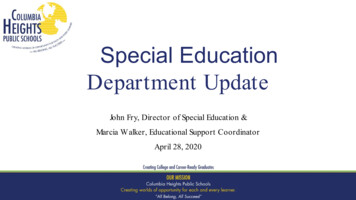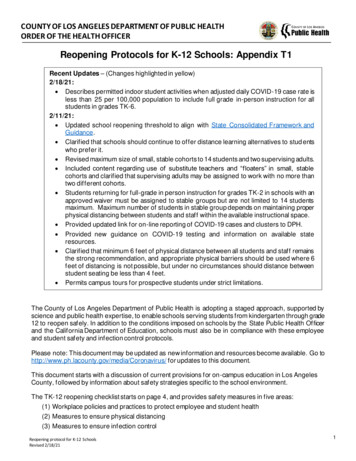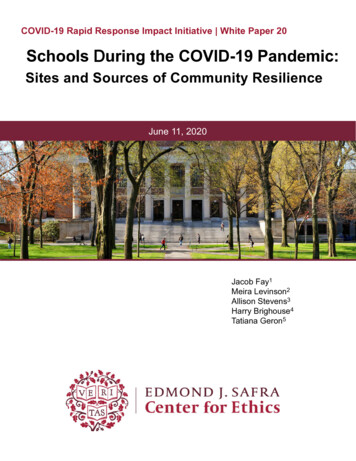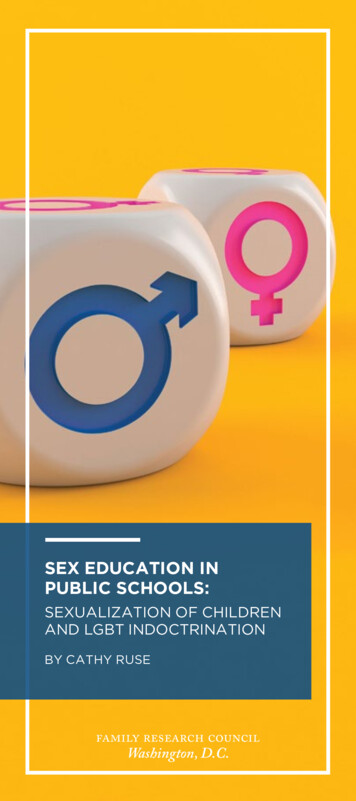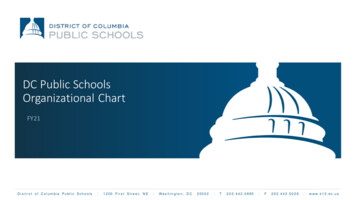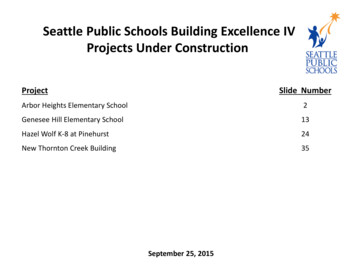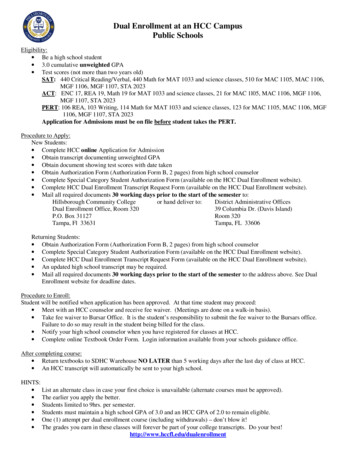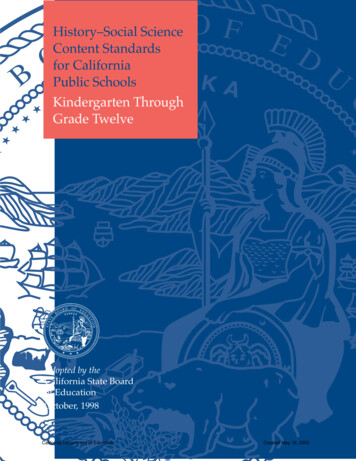
Transcription
BDRAOO FEDAdopted by theCalifornia State Boardof EducationOctober, 1998California Department of EducationUCHistory–Social ScienceContent Standardsfor CaliforniaPublic SchoolsKindergarten ThroughGrade TwelveCreated May 18, 2000
EDUTENSTAIADEPAROFNT IOCATENTMOFC A LIFORPublishing InformationWhen the History–Social Science Content Standards for California Public Schools,Kindergarten Through Grade Twelve was adopted by the California State Board of Educationon October 9, 1998, the members of the State Board were the following: Yvonne W. Larsen,President; Robert L. Trigg, Vice-President; Marian Bergeson; Timothy C. Draper; KathrynDronenburg; Marion Joseph; Marion McDowell; Janet G. Nicholas; Gerti B. Thomas; MarinaTse; and Richard Weston.This publication was edited by Bob Klingensmith, working in cooperation with Greg Geeting,Executive Director, and Gregory F. McGinity, Education Policy Consultant, State Board ofEducation. It was designed and prepared for printing by the staff of CDE Press, with the coverand interior design created and prepared by Cheryl McDonald. Typesetting was done by JamieContreras. It was published by the Department of Education, 721 Capitol Mall, Sacramento,California (mailing address: P.O. Box 944272, Sacramento, CA 94244-2720). It wasdistributed under the provisions of the Library Distribution Act and Government Code Section11096. 2000 by the California Department of EducationAll rights reservedISBN 0-8011-1488-8Special AcknowledgmentThe State Board of Education extends its appreciation to the members and staff of theCommission for the Establishment of Academic Content and Performance Standards(Academic Standards Commission) for their outstanding work in developing andrecommending the history–social science content standards to the State Board of Educationunder the provisions of Education Code Section 60605.The members and executive staff of the Academic Standards Commission at the time of theapproval of the draft history–social science content standards were the following:Ellen Wright, Chair*; Robert Calfee, Vice-Chair*; Mike Aiello; Joseph Carrabino; JudyCodding*; Daniel Condron; Linda Davis; Bill Evers; Tony Fisher; Jerilyn Harris; Dorothy JueLee; Mark Ortiz; Judith Panton*; Raymund Paredes*; Alice Petrossian*; Glenn T. Seaborg;Kate Simpson*; Lawrence Siskind*; Jerry Treadway*; LaTanya Wright*; Delaine Eastin, StateSuperintendent of Public Instruction; Sonia Hernandez, the Superintendent’s Designee; ScottHill, Executive Director; Sheila Byrd, Deputy Executive Director; Sue Pimentel, SeniorStandards Advisor; and Ellen Clark, Consultant.Note: The asterisk (*) identifies those members who served on the Academic StandardsCommission’s History–Social Science Committee.Special commendation is also extended to the leadership of Lawrence Siskind, Chair of theAcademic Standards Commission’s History–Social Science Committee; State Board ofEducation member Marion McDowell; Kirk Ankeney, Chair of the Curriculum Developmentand Supplemental Materials Commission; and Tom Adams, Consultant, CurriculumFrameworks and Instructional Resources Office, whose significant contributions to thisdocument deserve special recognition.Ordering InformationCopies of this publication are available for 9 each, plus shipping and handling charges.California residents are charged sales tax. Orders may be sent to CDE Press, Sales Office,California Department of Education, P.O. Box 271, Sacramento, CA 95812-0271; FAX (916)323-0823. See page 63 for a partial list of other educational resources available from theDepartment. In addition, an illustrated Educational Resources Catalog describing publications,videos, and other instructional media available from the Department can be obtained withoutcharge by writing to the address given above or by calling the Sales Office at (916) 445-1260.NoticeThe guidance in History–Social Science Content Standards for California Public Schools is notbinding on local educational agencies or other entities. Except for the statutes, regulations, andcourt decisions that are referenced herein, the document is exemplary, and compliance with itis not mandatory. (See Education Code Section 33308.5.)Prepared for publicationby CSEA members.iiCalifornia Department of EducationCreated May 18, 2000
ContentsA Message from the State Board of Education and the State Superintendentof Public Instruction . ivIntroduction . vKindergarten Through Grade FiveHistorical and Social Sciences Analysis Skills . 1Kindergarten: Learning and Working Now and Long Ago . 3Grade One: A Child’s Place in Time and Space . 5Grade Two: People Who Make a Difference . 7Grade Three: Continuity and Change . 9Grade Four: California: A Changing State . 12Grade Five: United States History and Geography: Making a New Nation . 16Grades Six Through EightHistorical and Social Sciences Analysis Skills . 21Grade Six: World History and Geography: Ancient Civilizations . 23Grade Seven: World History and Geography: Medieval and Early Modern Times . 27Grade Eight: United States History and Geography: Growth and Conflict . 33Grades Nine Through TwelveHistorical and Social Sciences Analysis Skills . 40Grade Ten: World History, Culture, and Geography: The Modern World . 42Grade Eleven: United States History and Geography: Continuity and Change inthe Twentieth Century . 47Grade Twelve: Principles of American Democracy and Economics . 54iiiCalifornia Department of EducationCreated May 18, 2000
A Message from the State Board of Education and theState Superintendent of Public InstructionSeventeen years ago the report A Nation atRisk, by the National Commission on Excellencein Education (1983), brought squarely to ourattention a “rising tide of mediocrity” in ourschools. An era of education reform began. Theresults were somewhat uneven. The reformmovement did stimulate important infrastructureimprovements: instructional time was increased,high school diplomas came to signify the comple tion of minimum course requirements, andemphasis was placed on local planning efforts toimprove the schools’ efficiency and effectiveness.A shortcoming of the movement up to this pointhas been the lack of focus on rigorous academicstandards. The desire to improve studentachievement guided the effort, but it lacked acomprehensive, specific vision of what studentsactually needed to know and be able to do.Standards are a bold initiative.With the adoption of content standards,California is going beyond reform. We are redefin ing the state’s role in public education. For thefirst time, we are stating—explicitly—the contentthat students need to acquire at each grade levelfrom kindergarten to grade twelve. These stan dards are rigorous. With student mastery of thiscontent, California schools will be on a par withthose in the best educational systems in otherstates and nations. The content is attainable by allstudents, given sufficient time, except for thosefew who have severe disabilities. We regard thestandards as firm but not unyielding; they will bemodified in future years to reflect new researchand scholarship.Standards describe what to teach,not how to teach it.Standards-based education maintainsCalifornia’s tradition of respect for local controlof schools. To help students achieve at highlevels, local school officials and teachers—withthe full support and cooperation of families,businesses, and community partners—areencouraged to take these standards and designthe specific curricular and instructional strategiesthat best deliver the content to their students.Standards are an enduring commitment,not a passing fancy.Every initiative in public education, especiallyone so bold as establishing high standards, hasits skeptics. “Just wait a while,” they say, “stan dards, too, will pass.” We intend to prove theskeptics wrong, and we intend to do that bycompletely aligning state efforts to these stan dards, including the statewide testing program,curriculum frameworks, instructional materials,professional development, preservice education,and compliance review. We will see a generationof educators who think of standards not as a newlayer but as the foundation itself.Standards are our commitment to excellence.Fifteen years from now, we are convinced, theadoption of standards will be viewed as thesignal event that began a “rising tide of excel lence” in our schools. No more will the criticalquestion What should my child be learning? be metwith uncertainty of knowledge, purpose, orresolve. These standards answer the question.They are comprehensive and specific. Theyrepresent our commitment to excellence.YVONNE W. LARSEN, PresidentCalifornia State Board of EducationDELAINE EASTINState Superintendent of Public InstructionivCalifornia Department of EducationCreated May 18, 2000
IntroductionThe California State Board of Educationhas worked hard with the Academic Stan dards Commission to develop history–social science standards that reflectCalifornia’s commitment to history–socialscience education. These standards empha size historical narrative, highlight the rolesof significant individuals throughouthistory, and convey the rights and obliga tions of citizenship.In that spirit the standards proceedchronologically and call attention to thestory of America as a noble experiment in aconstitutional republic. They recognize thatAmerica’s ongoing struggle to realize theideals of the Declaration of Independenceand the U.S. Constitution is the struggle tomaintain our beautifully complex nationalheritage of e pluribus unum. While thestandards emphasize Western civilizationsas the source of American political institu tions, laws, and ideology, they also expectstudents to analyze the changing politicalrelationships within and among othercountries and regions of the world, boththroughout history and within the contextof contemporary global interdependence.The standards serve as the basis forstatewide assessments, curriculum frame works, and instructional materials, butmethods of instructional delivery remainthe responsibility of local educators.Development of the StandardsThe recommended history–social sciencestandards build on the work of exemplarydocuments from both within and outsideCalifornia, most notably the History–SocialScience Framework for California PublicSchools, a document strengthened by theconsensus that elicited it and nationallyrecognized for its emphasis on historicalevents presented within a chronological andgeographic context.The standards reflect guidance and inputfrom countless members of the Californiateaching community and other citizens whoattended the meetings of the State Boardand Standards Commission. Their inputcontributed substantively to the discussionsand the drafts, as did the input gatheredfrom the nine directed community inputmeetings hosted by the Standards Commis sion throughout the state in January 1998and from the five field hearings held by theState Board throughout the state in August1998. At those forums, parents, teachers,administrators, and business and commu nity leaders helped define key issues.Current practice and the state of history–social science instruction in California werealso given special consideration during theprocess. In addition, history–social scienceexperts from around the nation reviewedvCalifornia Department of EducationCreated May 18, 2000
viINTRODUCTIONand submitted formal comments on the firstand second drafts. The more than 70 re viewers included eminent historians, geog raphers, economists, and political scientists.Their input helped immeasurably tostrengthen the rigor and quality of thestandards.Highlights of the StandardsWith the History–Social Science Frameworkfor California Public Schools as a guide to theeras and civilizations to study, these stan dards require students not only to acquirecore knowledge in history and social sci ence, but also to develop the critical think ing skills that historians and social scientistsemploy to study the past and its relation ship to the present. It is possible to spend alifetime studying history and not learnabout every significant historical event; noone can know everything. However, theState Board hopes that during their years offormal schooling, students will learn todistinguish the important from the unim portant, to recognize vital connectionsbetween the present and the past, and toappreciate universal historical themes anddilemmas.Throughout this document, the use ofbiographies, original documents, diaries,letters, legends, speeches, and other narra tive artifacts from our past is encouraged tofoster students’ understanding of historicalevents by revealing the ideas, values, fears,and dreams of the people associated withthem. Found in archives, museums, histori cal sites, and libraries across California,these original materials are indispensableresources. The State Board hopes schoolswill take advantage of these repositoriesand encourage students’ direct contact withhistory. The standards also emphasize theCalifornia Department of Educationimportance of enriching the study of historythrough the use of literature, both from andabout the period being studied.Mastery of these standards will ensurethat students not only know the facts, butalso understand common and complexthemes throughout history, making connec tions among their own lives, the lives of thepeople who came before them, and the livesof those to come. The statements at thebeginning of each grade provide a briefoverview of the greater story under study.The overarching statements in each gradeand their substatements function as concep tual units: the numbered items under eachoverarching standard delineate aspects ofthe bigger concept that students are ex pected to master. In this way, teachers andassessors can focus on the concept withoutneglecting the essential components of each.The standards include many exemplarylists of historical figures that could bestudied. These examples are illustrative.They do not suggest that all of the figuresmentioned are required for study, nor dothey exclude the study of additional figuresthat may be relevant to the standards.The standards do not exist in isolation.The History–Social Science Framework will berevised to align with the standards, and itwill include suggested ways to relate thestandards’ substance to students, ways tomake connections within and across grades,and detailed guidance for day-to-dayinstruction and lesson plans. Teachersshould use these documents together.Knowledge and skills increase in com plexity in a systematic fashion from kinder garten through grade twelve, although nostandards exist for grade nine in deferenceto current California practice in whichgrade nine is the year students traditionallychoose a history–social science elective.Created May 18, 2000
INTRODUCTIONHowever, in the coming years, the StateBoard intends to review this current practice.In kindergarten through grade three,students are introduced to the basic conceptsof each discipline: history, geography, civics,and economics. Beginning at grade four, thedisciplines are woven together within thestandards at each grade.The critical thinking skills that support thestudy of history–social science are outlinedin the sections for grades five, eight, and ten.To approach subject matter as historians,California Department of Educationviigeographers, economists, and politicalscientists, students are expected to employthese skills as they master the content.While the State Board recognizes that itwill take both time and changes in policiesfor schools, teachers, and students to meetthese standards, we believe it can and mustbe done. When students master the contentand develop the skills contained in thesestandards, they will be well equipped forthe twenty-first century.Created May 18, 2000
KINDERGARTENKindergartenThroughGrade FiveHistorical and Social Sciences Analysis SkillsThe intellectual skills noted below are to be learned through, and applied to, the contentstandards for kindergarten through grade five. They are to be assessed only in conjunc tion with the content standards in kindergarten through grade five.In addition to the standards for kindergarten through grade five, students demonstrate thefollowing intellectual, reasoning, reflection, and research skills:Chronological and Spatial Thinking1. Students place key events and people of the historical era they are studying in a chrono logical sequence and within a spatial context; they interpret time lines.2. Students correctly apply terms related to time, including past, present, future, decade,century, and generation.3. Students explain how the present is connected to the past, identifying both similaritiesand differences between the two, and how some things change over time and some thingsstay the same.4. Students use map and globe skills to determine the absolute locations of places andinterpret information available through a map’s or globe’s legend, scale, and symbolicrepresentations.5. Students judge the significance of the relative location of a place (e.g., proximity to aharbor, on trade routes) and analyze how relative advantages or disadvantages canchange over time.Research, Evidence, and Point of View1. Students differentiate between primary and secondary sources.2. Students pose relevant questions about events they encounter in historical documents,eyewitness accounts, oral histories, letters, diaries, artifacts, photographs, maps, artworks,and architecture.3. Students distinguish fact from fiction by comparing documentary sources on historicalfigures and events with fictionalized characters and events.California Department of Education1Created May 18, 2000
KINDERGARTENHistorical Interpretation1. Students summarize the key events of the era they are studying and explain the historicalcontexts of those events.2. Students identify the human and physical characteristics of the places they are studyingand explain how those features form the unique character of those places.3. Students identify and interpret the multiple causes and effects of historical events.4. Students conduct cost-benefit analyses of historical and current events.2CaliforniaDepartment of EducationCreated May 18, 2000
3KindergartenLearning and Working Now and Long AgoStudents in kindergarten are introduced to basic spatial, temporal, and causal relation ships, emphasizing the geographic and historical connections between the world todayand the world long ago. The stories of ordinary and extraordinary people help describethe range and continuity of human experience and introduce the concepts of courage,self-control, justice, heroism, leadership, deliberation, and individual responsibility.Historical empathy for how people lived and worked long ago reinforces the concept ofcivic behavior: how we interact respectfully with each other, following rules, and re specting the rights of others.K.1 Students understand that being a good citizen involves acting in certain ways.1. Follow rules, such as sharing and taking turns, and know the consequences of break ing them.2. Learn examples of honesty, courage, determination, individual responsibility, andpatriotism in American and world history from stories and folklore.3. Know beliefs and related behaviors of characters in stories from times past and under stand the consequences of the characters’ actions.K.2 Students recognize national and state symbols and icons such as the nationaland state flags, the bald eagle, and the Statue of Liberty.K.3 Students match simple descriptions of work that people do and the namesof related jobs at the school, in the local community, and from historical ac counts.3California Department of EducationCreated May 18, 2000
4KINDERGARTENK.4 Students compare and contrast the locations of people, places, andenvironments and describe their characteristics.1. Determine the relative locations of objects using the terms near/far, left/right, andbehind/in front.2. Distinguish between land and water on maps and globes and locate general areasreferenced in historical legends and stories.3. Identify traffic symbols and map symbols (e.g., those for land, water, roads, cities).4. Construct maps and models of neighborhoods, incorporating such structures as policeand fire stations, airports, banks, hospitals, supermarkets, harbors, schools, homes,places of worship, and transportation lines.5. Demonstrate familiarity with the school’s layout, environs, and the jobs people dothere.K.5 Students put events in temporal order using a calendar, placing days,weeks, and months in proper order.K.6 Students understand that history relates to events, people, and places ofother times.1. Identify the purposes of, and the people and events honored in, commemorativeholidays, including the human struggles that were the basis for the events (e.g.,Thanksgiving, Independence Day, Washington’s and Lincoln’s Birthdays, MartinLuther King Jr. Day, Memorial Day, Labor Day, Columbus Day, Veterans Day).2. Know the triumphs in American legends and historical accounts through the stories ofsuch people as Pocahontas, George Washington, Booker T. Washington, Daniel Boone,and Benjamin Franklin.3. Understand how people lived in earlier times and how their lives would be differenttoday (e.g., getting water from a well, growing food, making clothing, having fun,forming organizations, living by rules and laws).California Department of EducationCreated May 18, 2000
5Grade OneA Child’s Place in Time and SpaceStudents in grade one continue a more detailed treatment of the broad concepts ofrights and responsibilities in the contemporary world. The classroom serves as a micro cosm of society in which decisions are made with respect for individual responsibility,for other people, and for the rules by which we all must live: fair play, good sportsman ship, and respect for the rights and opinions of others. Students examine the geographicand economic aspects of life in their own neighborhoods and compare them to those ofpeople long ago. Students explore the varied backgrounds of American citizens andlearn about the symbols, icons, and songs that reflect our common heritage.1.1Students describe the rights and individual responsibilities of citizenship.1. Understand the rule-making process in a direct democracy (everyone votes onthe rules) and in a representative democracy (an elected group of people makethe rules), giving examples of both systems in their classroom, school, andcommunity.2. Understand the elements of fair play and good sportsmanship, respect for therights and opinions of others, and respect for rules by which we live, includingthe meaning of the “Golden Rule.”1.2Students compare and contrast the absolute and relative locations of placesand people and describe the physical and/or human characteristics of places.1. Locate on maps and globes their local community, California, the United States,the seven continents, and the four oceans.2. Compare the information that can be derived from a three-dimensional modelto the information that can be derived from a picture of the same location.3. Construct a simple map, using cardinal directions and map symbols.4. Describe how location, weather, and physical environment affect the waypeople live, including the effects on their food, clothing, shelter, transportation,and recreation.5California Department of EducationCreated May 18, 2000
61.3GRADE ONEStudents know and understand the symbols, icons, and traditions of the UnitedStates that provide continuity and a sense of community across time.1. Recite the Pledge of Allegiance and sing songs that express American ideals (e.g., “MyCountry ’Tis of Thee”).2. Understand the significance of our national holidays and the heroism and achieve ments of the people associated with them.3. Identify American symbols, landmarks, and essential documents, such as the flag, baldeagle, Statue of Liberty, U.S. Constitution, and Declaration of Independence, and knowthe people and events associated with them.1.4Students compare and contrast everyday life in different times and placesaround the world and recognize that some aspects of people, places, and thingschange over time while others stay the same.1. Examine the structure of schools and communities in the past.2. Study transportation methods of earlier days.3. Recognize similarities and differences of earlier generations in such areas as work(inside and outside the home), dress, manners, stories, games, and festivals, drawingfrom biographies, oral histories, and folklore.1.5Students describe the human characteristics of familiar places and the variedbackgrounds of American citizens and residents in those places.1. Recognize the ways in which they are all part of the same community, sharing prin ciples, goals, and traditions despite their varied ancestry; the forms of diversity in theirschool and community; and the benefits and challenges of a diverse population.2. Understand the ways in which American Indians and immigrants have helped defineCalifornian and American culture.3. Compare the beliefs, customs, ceremonies, traditions, and social practices of the variedcultures, drawing from folklore.1. 6Students understand basic economic concepts and the role of individual choicein a free-market economy.1. Understand the concept of exchange and the use of money to purchase goods andservices.2. Identify the specialized work that people do to manufacture, transport, and marketgoods and services and the contributions of those who work in the home.California Department of EducationCreated May 18, 2000
7Grade TwoPeople Who Make a DifferenceStudents in grade two explore the lives of actual people who make a difference in theireveryday lives and learn the stories of extraordinary people from history whoseachievements have touched them, directly or indirectly. The study of contemporarypeople who supply goods and services aids in understanding the complex interdepen dence in our free-market system.2.1Students differentiate between things that happened long ago and thingsthat happened yesterday.1. Trace the history of a family through the use of primary and secondary sources,including artifacts, photographs, interviews, and documents.2. Compare and contrast their daily lives with those of their parents, grandparents,and/or guardians.3. Place important events in their lives in the order in which they occurred (e.g., on atime line or storyboard).2.2Students demonstrate map skills by describing the absolute and relative loca tions of people, places, and environments.1. Locate on a simple letter-number grid system the specific locations and geographicfeatures in their neighborhood or community (e.g., map of the classroom, the school).2. Label from memory a simple map of the North American continent, including thecountries, oceans, Great Lakes, major rivers, and mountain ranges. Identify the essen tial map elements: title, legend, directional indicator, scale, and date.3. Locate on a map where their ancestors live(d), telling when the family moved to thelocal community and how and why they made the trip.4. Compare and contrast basic land use in urban, suburban, and rural environments inCalifornia.7California Department of EducationCreated May 18, 2000
82.3GRADE TWOStudents explain governmental institutions and practices in the United Statesand other countries.1. Explain how the United States and other countries make laws, carry out laws, deter mine whether laws have been violated, and punish wrongdoers.2. Describe the ways in which groups and nations interact with one another to try toresolve problems in such areas as trade, cultural contacts, treaties, diplomacy, andmilitary force.2.4Students understand basic economic concepts and their individual roles in theeconomy and demonstrate basic economic reasoning skills.1. Describe food production and consumption long ago and today, including the roles offarmers, processors, distributors, weather, and land and water resources.2. Understand the role and interdependence of buyers (consumers) and sellers (produc ers) of goods and services.3. Understand how limits on resources affect production and consumption (what toproduce and what to consume).2.5Students understand the importance of individual action and character andexplain how heroes from long ago and the recent past have made a difference inothers’ lives (e.g., from biographies of Abraham Lincoln, Louis Pasteur, SittingBull, George Washington Carver, Marie Curie, Albert Einstein, Golda Meir,Jackie Robinson, Sally Ride).California Department of EducationCreated May 18, 2000
9Grade ThreeContinuity and ChangeStudents in grade three learn more about our connections to the past and the ways inwhich particul
Grade Six: World History and Geography: Ancient Civilizations . 23 Grade Seven: World History and Geography: Medieval and Early Modern Times . 27 Grade Eight: United States History and Geography: Growth and Conflict . 33. Grades Nine Through Tw
